The image above shows three cuckoos of the Shanghai region. Clockwise from L: Rufous Hawk-Cuckoo, Chestnut-winged Cuckoo, and Large Hawk-Cuckoo. Join us as we study the rich array of cuckoos that passes through Shanghai.
by Craig Brelsford
Founder, shanghaibirding.com
It is spring, and one of the most thrilling moments of the bird migration in Shanghai is upon us—the passage of the Cuculinae, the Old World brood-parasitic cuckoos. Nowhere in the world is the diversity of this group greater than in eastern Eurasia, and here in Shanghai we get an enviable selection. Let us examine our Shanghai-area parasitic cuckoos and learn how to tell them apart.
We can divide the Shanghai-area brood-parasitic cuckoos into two categories: the mainly grey, slender-bodied Cuculus cuckoos and the non-Cuculus cuckoos. We will look at the non-Cuculus cuckoos first.
MASTER MIMICS: THE HAWK-CUCKOOS

The non-Cuculus parasitic cuckoo that one is most likely to see in Shanghai is Large Hawk-Cuckoo Hierococcyx sparverioides. In the microforests at Cape Nanhui and once, to my surprise, in inner-city Zhongshan Park, I have heard the scream of “Brain fever!” The species breeds in nearby Jiangsu and Zhejiang.
The hawk-cuckoos mimic sparrowhawks, an amazing feat of evolution. The resemblance serves, scientists say, not to increase stealth but to decrease it. Passerines, mistaking the intruder for a sparrowhawk, mob it, thereby giving away the location of their nest. After the tumult dies down, the hawk-cuckoo quietly swoops in and lays her egg.
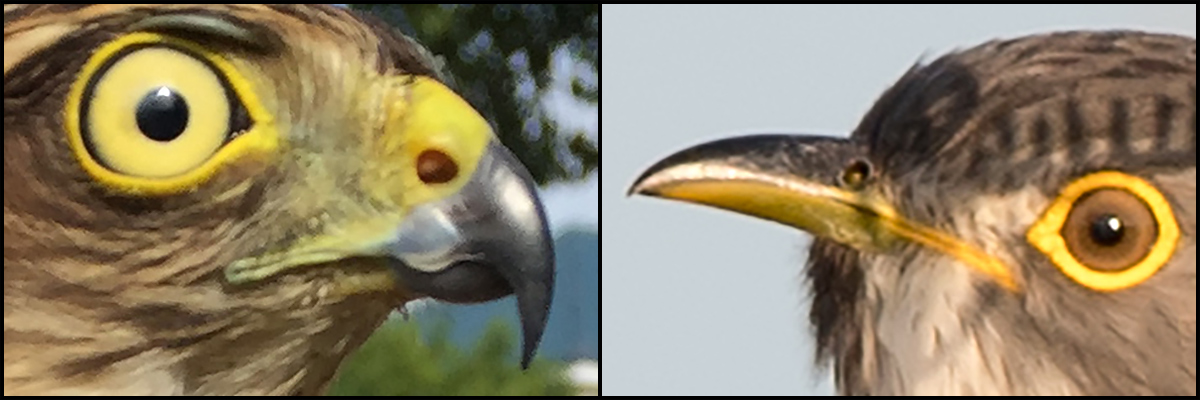
When it comes to the business of eating, however, the masquerade ends. The hooked bill of a sparrowhawk is a butcher’s tool, made for stripping the flesh of vertebrates from bone. The bill of a hawk-cuckoo is blunt, the utensil of a caterpillar-eater. Need a quick differentiator between “sprock” and hawk-cuckoo? Look to the bill.

Another separation we Shanghai birders need to make is that between Large Hawk-Cuckoo and Rufous Hawk-Cuckoo Hierococcyx hyperythrus. If seen clearly, adult Large Hawk-Cuckoo and Rufous Hawk-Cuckoo are readily separable. Rufous Hawk-Cuckoo shows a belly washed rufous with faint streaks. Large Hawk-Cuckoo is heavily barred and streaked and has the rufous coloring confined to the upper breast.
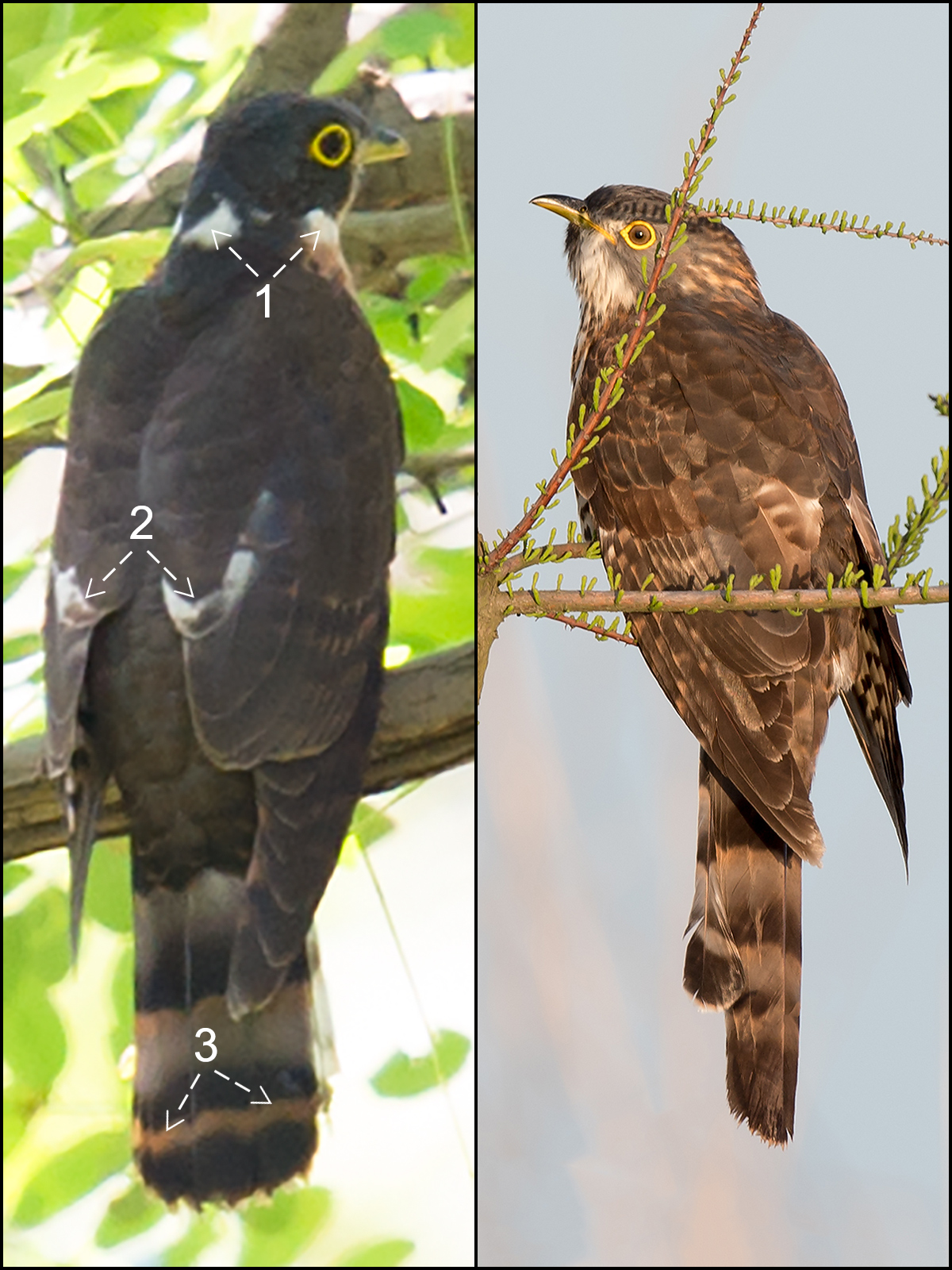
Adult Rufous Hawk-Cuckoo shows a white spot on the nape, white neck-sides, and white scapular crescents. These features may also be visible in sub-adult Rufous Hawk-Cuckoo. Large Hawk-Cuckoo shows none of these in any plumage.

Size differences may be appreciable. An average Large Hawk-Cuckoo is 15 percent larger than Rufous Hawk-Cuckoo. The tails differ, with the black subterminal band of Rufous Hawk-Cuckoo being bordered by a rufous line above and by the rufous tail-tip below. These rufous areas may be visible in immature cuckoos.
ASIAN KOEL AND CHESTNUT-WINGED CUCKOO

The other non-Cuculus parasitic cuckoos of the Shanghai region are Asian Koel Eudynamys scolopaceus and Chestnut-winged Cuckoo Clamator coromandus. Neither poses great ID challenges.
In China, Asian Koel ssp. chinensis breeds mainly south of the Yangtze River. With its familiar “koh-EL” song, Asian Koel is as easy to hear as it is hard to see in the dense forests where it is almost invariably found. It shows strong sexual dimorphism, with the male entirely glossy bluish-black and the female brown with whitish streaks, bars, and spots.

I have yet to see Chestnut-winged Cuckoo in Shanghai, but others have noted it at Cape Nanhui. I have seen the species at Laoshan (32.071265, 118.560699) in Nanjing as well as in Zhejiang in the Tianmu Mountains (30.344148, 119.440201). With its glossy-black erectile crest, rufous wings, and long, black tail, the species is unmistakable—if you can manage to see it.
SHANGHAI-AREA CUCULUS CUCKOOS

Five Cuculus cuckoos have been claimed for Shanghai: Lesser Cuckoo Cuculus poliocephalus, Indian Cuckoo C. micropterus, Himalayan Cuckoo C. saturatus, Oriental Cuckoo C. optatus, and Common Cuckoo C. canorus.
The latter breeds in the area, parasitizing the nests of Oriental Reed Warbler in the reed beds at Cape Nanhui. Its famous song, perhaps the best-known bird sound in the world, is hard to miss at Nanhui in May.
Lesser Cuckoo and Indian Cuckoo breed in the region and are recorded on passage in Shanghai. Himalayan Cuckoo and Oriental Cuckoo may pass through Shanghai, but as in size, plumage, and bare parts they are nearly identical to each other and very close to Common Cuckoo, and because they rarely (if ever) sing in our region, it is very difficult to know how common they are.
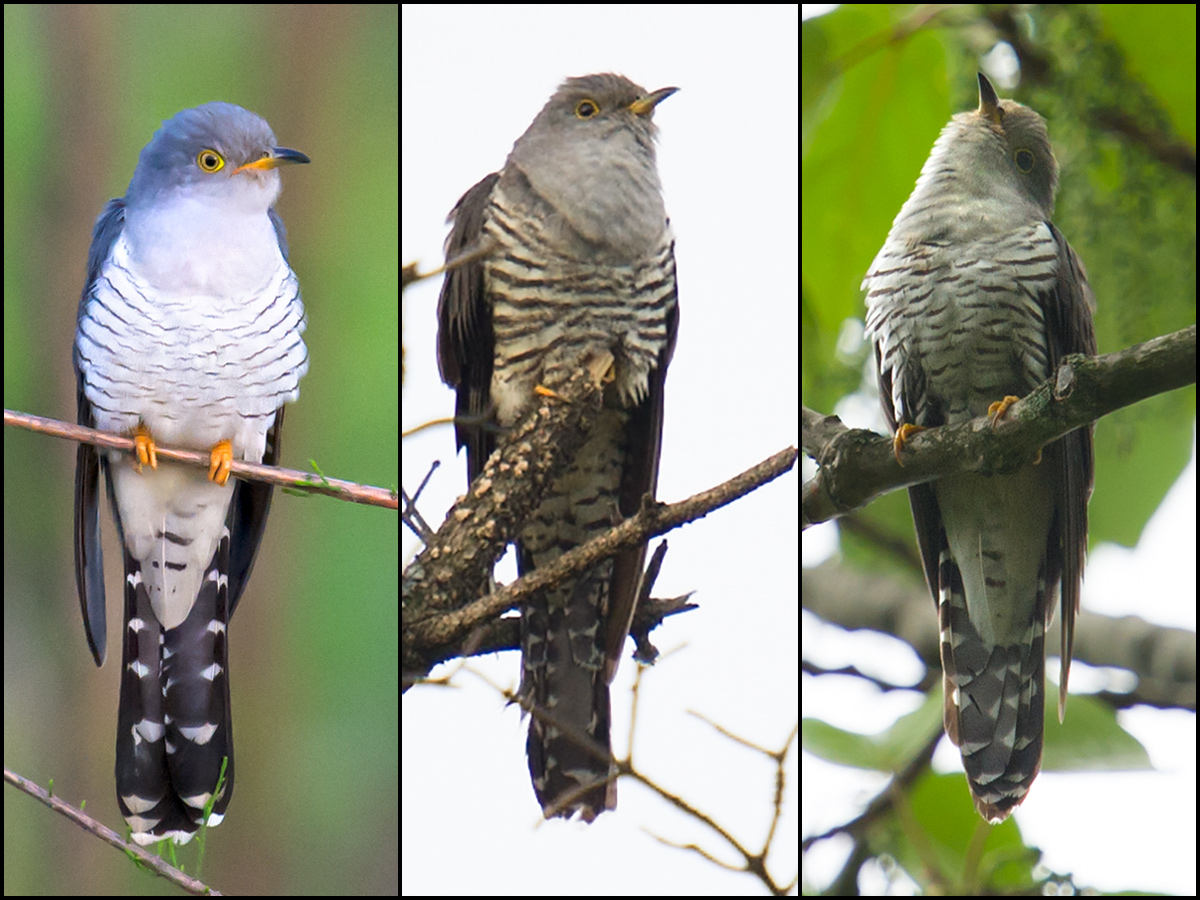
Hear the song of any of these Cuculus, and you will have your ID; even the similar songs of Himalayan and Oriental are readily separable. If your cuckoo is silent, however, then you will need a closer look. Lesser Cuckoo and Indian Cuckoo have a brown iris, Common Cuckoo a bright-yellow iris. Lesser Cuckoo is the size of a thrush; Indian Cuckoo is a third larger; Common Cuckoo is larger still, approaching the size of a female Eurasian Sparrowhawk.
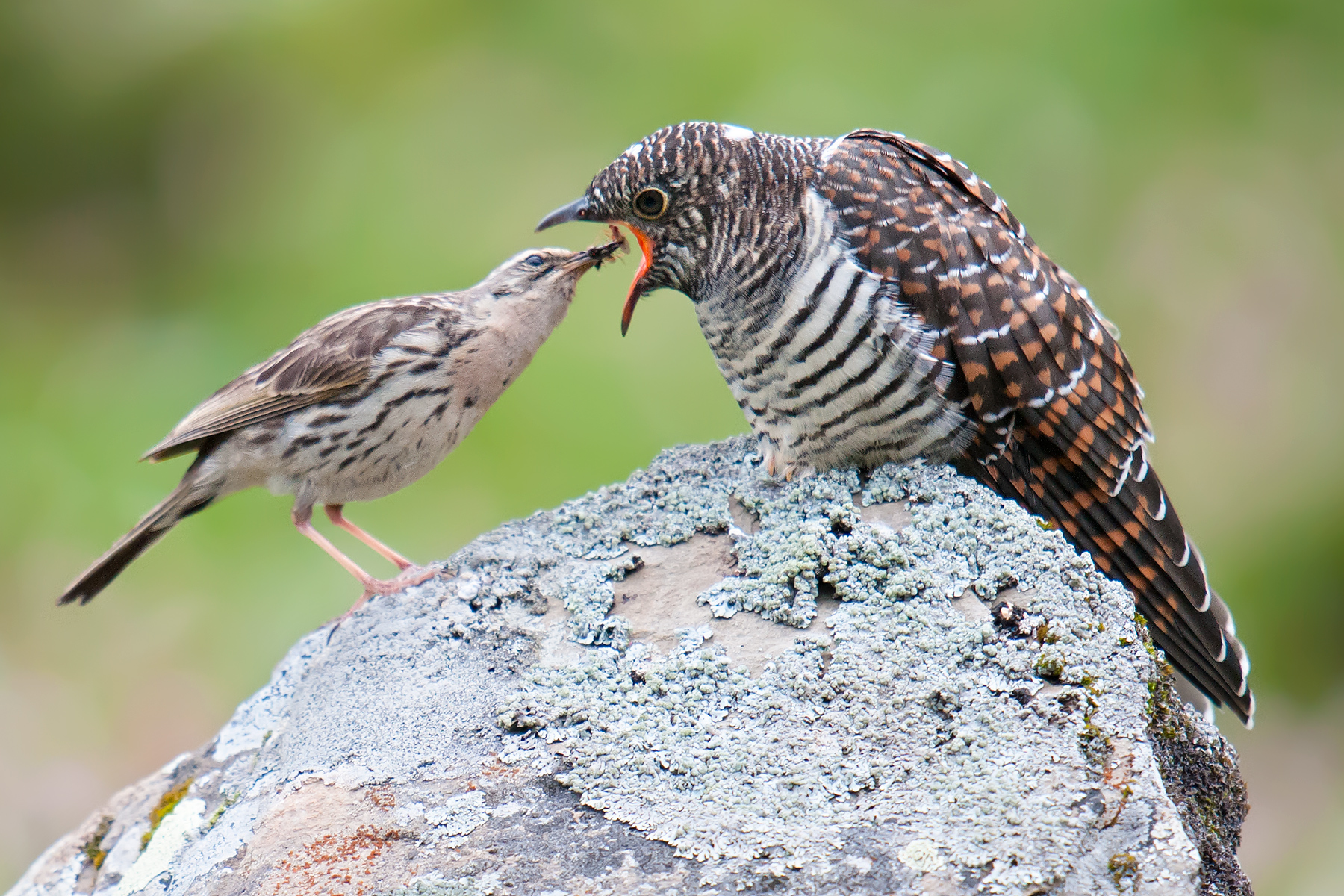
In autumn, juveniles pass through Shanghai. They are silent and nearly impossible to identify to species. If one gets a close look at juvenile Lesser Cuckoo, however, one may appreciate its thrush-like size. If you happen to be on the breeding grounds, then you can attempt an ID according to the species of the foster parent.
NON-CUCULINAE CUCKOOS
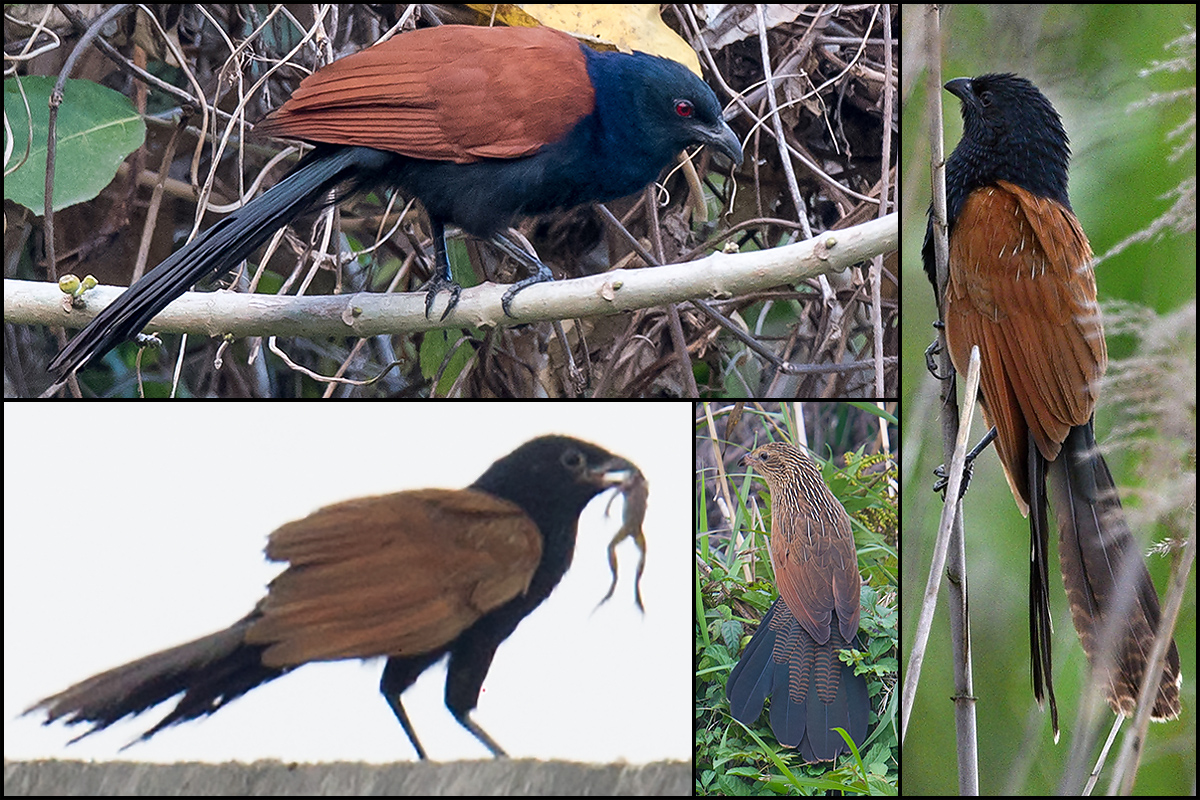
Lesser Coucal Centropus bengalensis is the good guy among the cuckoos of Shanghai. Unlike all the other cuckoos recorded in Shanghai, but like most of the cuckoos in the world, the coucals are not brood parasites. Lesser Coucal, resident in Shanghai, builds a dome nest on the ground.
Lesser Coucal may be the only non-Cuculinae cuckoo in Shanghai, but it shares at least one trait with the brood parasites: It is very unobtrusive. Look for Lesser Coucal in areas of thick vegetation near water, such as the strips of reed bed along the canals at Cape Nanhui. If you find one, count yourself lucky.
Greater Coucal Centropus sinensis occurs south of our region. It is nearly half again as large as Lesser Coucal and has a cleaner and glossier mantle, a thicker bill, and a redder iris.
RESOURCES ON CUCKOOS

The Sounds of Shanghai’s Cuckoos, by Craig Brelsford
All cuckoos from the Shanghai area are covered here. I make my recordings with my Olympus DM-650.
Lesser Coucal, Centropus bengalensis, Jiangsu, June (00:06; 1.1 MB)
Chestnut-winged Cuckoo Clamator coromandus, West Tianmu Mountain Nature Reserve, Zhejiang, May (00:43; 3.3 MB)
Asian Koel Eudynamys scolopaceus, Jiangsu, May (00:39; 2.4 MB)
Large Hawk-Cuckoo Hierococcyx sparverioides, Sichuan, June (03:21; 4 MB)
Rufous Hawk-Cuckoo Hierococcyx hyperythrus, Heilongjiang, June (01:06; 3.4 MB)
Lesser Cuckoo Cuculus poliocephalus, Sichuan, June (00:16; 1 MB)
Indian Cuckoo Cuculus micropterus, classic four-note song plus bubbly flourish, Heilongjiang, June (00:02; 901 KB)
Himalayan Cuckoo Cuculus saturatus, singing and quarreling, Sichuan, June (00:28; 1.2 MB)
Oriental Cuckoo Cuculus optatus, classic double note “boop boop” faintly from a distance, Heilongjiang, May (00:03; 600 KB)
Common Cuckoo Cuculus canorus, classic song plus cough, Cape Nanhui, Shanghai, May (00:03; 913 KB)
REFERENCES
Brazil, Mark. Birds of East Asia. Princeton University Press. Cuckoos, pp. 254-9.
del Hoyo, Josep, et al., eds. The Handbook of the Birds of the World. Lynx Edicions. Vol. 4, “Sandgrouse to Cuckoos.” Cuculidae (pp. 508-607) by R. B. Payne.
MacKinnon, John & Karen Phillipps. A Field Guide to the Birds of China. Oxford University Press.
Featured image: Clockwise from L, Rufous Hawk-Cuckoo Hierococcyx hyperythrus, Jiangsu, October; Chestnut-winged Cuckoo Clamator coromandus, Jiangsu, July; and Large Hawk-Cuckoo Hierococcyx sparverioides, Cape Nanhui, Shanghai, May. (Craig Brelsford)


Two years ago I had excellent views of Chestnut-winged Cuckoo at Nanjing in some extensive woodland on a hill where there is a big temple. Also at the site were Fairy Pitta, Forest Wagtail and Brown-Chested Jungle Flycatcher amongst a lot of others.
Hi Mike, You had your view of Chestnut-winged Cuckoo at Laoshan, on the north shore of the Yangtze River in Nanjing. That’s where I got my photo of Chestnut-winged Cuckoo at the top of this post.
Hi Craig, I’m Kelvin, I live in Shanghai, I like photography as a hobby and quite interested in birds, I wonder if I can join the shanghai birding wechat group.
You can! Friend me on WeChat (WeChat ID: craigbrelsford), message me saying you want to join Shanghai Birding, and I’ll add you.
Hi Craig
I am a keen birder and would like to commend you on the fine article about id problems with cuckoos that you posted on the shanghai birding website.
I have a few pics of a bird that I saw, and would be grateful if you could assist if possible.
Please find here the pics concerned:
https://www.shanghaibirding.com/wp-content/uploads/2020/05/chisnall-cuckoo1.jpg
https://www.shanghaibirding.com/wp-content/uploads/2020/05/chisnall-cuckoo2.jpg
https://www.shanghaibirding.com/wp-content/uploads/2020/05/chisnall-cuckoo3.jpg
https://www.shanghaibirding.com/wp-content/uploads/2020/05/chisnall-cuckoo4.jpg
https://www.shanghaibirding.com/wp-content/uploads/2020/05/chisnall-cuckoo5.jpg
I appreciate you said id of juveniles is very hard. Still if you would be able to throw a few pointers my way it would be really appreciated.
Hi Earnest, Thank you for reading shanghaibirding.com, and congratulations on your excellent pictures of a secretive species. You offer no information on the place where you observed the cuckoo, nor do you tell me when you saw it. If you can supply that information, then we may be able to move closer to an ID, though as I say in the post and as you surely understand, ascertaining down to the species level may be impossible. Kind regards, Craig Brelsford
Hi Craig, Thank you for your kind reply. What I try to do as part of my birding “learning curve” as it were, is to try and pin identity on a species “irrespective” of location/range. A bit of a theoretical excercise really. Mind you that approach has helped me to learn about one or two different species of birds so far. I hope you don’t think that is being a bit silly.
Well I did see the Cuckoo in question in Bulgaria whilst on holiday there. I do appreciate that means it HAS to be a Common Cuckoo on location basis.
I saw from your excellent article that the “grey rump” pretty much rules out even the “theoretical” possibility of Indian Cuckoo or Lesser Cuckoo, and limits one to either Himalayan or Oriental. I just wondered if there might be anthing else you can notice of interest here please.
Hi Ian, I appreciate your method. You build your ID around the hard evidence of plumage, bare parts, and voice and rely less or not at all on the circumstantial evidence of place and time. Your rigorous method is especially appropriate in underbirded places such as China, where it can be very imperfectly known which species is supposed to be in a given place.
As I write below, in my entry for Common Cuckoo (https://www.shanghaibirding.com/tag/common-cuckoo/), the five Cuculus cuckoos of China are hard to tell apart. Draw a circle around the five cuckoos. Within that circle, draw three circles: one around Indian, one around Lesser, and one around Common, Himalayan, and Oriental. Within the Common-Himalayan-Oriental circle, make yet another circle around Himalayan and Oriental. Within the Himalayan-Oriental circle, I would attempt an ID on voice alone, as the structural features are identical or where not identical overlap to such a great extent as to make the distinctions meaningless to anyone except perhaps the most expert researcher. Within the Common-Himalayan-Oriental circle, I remain very suspicious of IDs based on anything but voice, but among Common and Himalayan-Oriental certain features (such as vent and thickness of barring) that overlap less than in Himalayan-Oriental do seem to exist. Within the circle containing all five species, I have been able to separate out silent Indian (on color of iris; see https://www.shanghaibirding.com/indian-cuckoo/) and silent Lesser (on size; see https://www.shanghaibirding.com/lesser-cuckoo/).
Here is an excerpt from my Common Cuckoo entry linked to above:
Of the five similar Cuculus cuckoos in China (Common, Himalayan, Indian, Lesser, and Oriental), Common is largest, but size alone rarely enough for a positive identification. The best differentiator is voice, and that of Common is instantly recognizable, the disyllabic “KOO-koo” (emphasis on first syllable) being one of the best-known bird sounds. Usually silent outside breeding season, making identification of migrating Common difficult. All five of the similar Cuculus cuckoos are long-tailed and slender, with adults grey-hooded and having similarly colored grey upperparts. Tail darker than upperparts, approaching black, with some white spotting. Underparts whitish, with black bars (less so on lower belly and vent). Legs short, yellow; wings long, pointed. All are insectivorous, with caterpillars in particular being taken, and in their rapid flight these cuckoos can be mistaken for a falcon or hawk. All are brood parasites and secretive forest dwellers. Common most closely resembles Himalayan and Oriental; like them, and unlike Indian and Lesser, Common has a grey rump that contrasts with its darker tail. The bars of Common often appear thinner than those of Oriental and Himalayan, and the vent is usually whiter (often buffish in Oriental and Himalayan). Bill yellow at base, with black tip; iris and eye-ring yellow. Eye of Indian Cuckoo is darker.
Your cuckoo, viewed as it was in Bulgaria, is almost certainly Common, but I think you already knew that. I hope I’ve provided some basis for an ID based not on place, time, and voice. Thanks again for using shanghaibirding.com.